- Cooling and Ventilation Equipment
- 0 likes
- 3227 views
- 0 comments
In an air-cooled chiller, heat is rejected directly into the outdoor air by using coils and fans that send fresh air over those coils to remove the heat.
Air Cooled Chiller Selection Tips
The vapor compression chiller is employed to supply water or cold gaseous refrigerant in AC or industrial refrigeration systems operating at 7–12 °C (depending on the application and requirements) by the vapor compression refrigeration cycle. An air-cooled chiller, as a type of vapor compression chiller, serves as the heart of the cooling system for buildings in climates with high Relative Humidity (RH) where it is not possible to use cooling towers and water-cooled chillers. Air-cooled vapor compression chillers, which are often installed in open spaces (such as rooftops), operate by a vapor compression refrigeration cycle similar to water-cooled chillers.
The main reason for installing an air-cooled chiller in an open space is for the condenser to be capable of thermal exchange with fresh air.
Click to view brands, models, and different types, find out the price, and buy an air-cooled chiller.
The Main Components of Air Cooled Chiller
- Compressor
- Condenser
- Evaporator
- Expansion valve
A larger amount of refrigerant circulates the air-cooled chiller, and at higher working pressure, than water-cooled chillers, which are cooled down in the condenser by forced convection, entering the cooling coil of the water-cooled DX air handling unit or the evaporator DX. It is important to note the difference between the nominal and actual capacities of the chiller—particularly, considering the local design outdoor summer temperature. Further, note whether the condenser and chiller heat transfer surface area—as determining factors—at the claimed capacity (length, size, and the number of tubes used in the condenser and the evaporator) are sufficient. An air-cooled chiller (including an air-cooled condenser, gaseous refrigerant, and oil) is 1.5 times more expensive than water-cooled chillers of a similar capacity.
Damatajhiz; The best prices and brands of building installation equipment
In general, to calculate the required chiller capacity in a project, based on the exact total refrigeration load, facilities engineers take into account the amount of required cold water and safety factors for the correct function of the chiller in addition to such parameters as the climatic conditions (ambient temperature), the design outdoor summer temperature, elevation, relative air humidity, building use (design indoor temperature), type of incorporated materials and the facade, orientation of the building relative to the sun angle, number of residents and small or large electrical equipment in the building. However, as a rule of thumb (phase 1 calculations), the required nominal capacity for residential and office buildings in a climate similar to Tehran can be estimated at 4 tons of refrigeration per 100 square meters of effective floor area.
Further, before determining the final capacity and selecting an air-cooled chiller, contact our specialists at DamaTajhiz for consultation and to control the estimations of the refrigeration load for accuracy.
Refrigeration Cycles in Air Cooled Chiller
The gaseous refrigerant is compressed by compressors of the air-cooled chiller. The compressed gas enters the condenser at high pressure and temperature and is cooled down by the water or ambient air until it transforms into a liquid. The liquid refrigerant then passes an expansion valve or a capillary that serves to reduce the pressure. The refrigerant enters the evaporator coil at a low temperature to be able to collect heat from the water circulating it. The refrigerant evaporates due to the lower pressure in the evaporator than in the condenser, with the required heat supplied by the water coming from the AC system. The refrigeration water is, therefore, cooled down and then transported to the cooling coils of the fan coil or air handling units by circulator pumps to supply the room with cool air. Then, the cycle repeats with the evaporated refrigerant returning to the compressor.
Technical Information for Air Cooled Chiller
The operating temperature of the chiller in AC systems is the temperature of chilled water leaving the evaporator that shall never fall below 7 °C.
Further, the temperature of the water returning to the evaporator at the peak system load must be nearly 5 degrees hotter than the water leaving the evaporator (moreover, it must be noted that the anti-freeze thermostat is often adjusted 4 degrees higher).
The function of the multi-stage evaporator thermostat in the chiller: The chiller system can be controlled according to the temperature on which the slow-opening thermostat is adjusted by using 3 or 4-stage thermostats depending on the type of equipment, number of compressors, number of air-cooled chiller circuits, and even the unloader system installed at the outlet of the evaporator.
Installing an unloader system in the compressor of the air-cooled chiller system can reduce power consumption when the refrigeration load decreases. Capacity control, or the unloader mechanism, is used to reduce the load during start-up and control the capacity during operation proportionately to the required refrigeration, which extends the service life of the equipment and increases its efficiency, thus considerably reducing the costs of energy consumption and maintenance. Unloading the compressor in proportion to the reduction of the load exerted on the system not only reduces the power input to the compressor but also decreases the stress on the motor and compressor due to sequential start-up and shut-down.
Four Technical Issues About Air Cooled Chiller
- Free cooling in air-cooled chillers
- Refrigerant superheating in the intake line of vapor compression chillers
- Condenser subcooling in vapor compression chillers
- Doing a pump-down in vapor compression chillers
Types of Compressors in Air Compression Chillers
When deciding to purchase air-cooled chiller systems, note the number, capacity, and manufacturer of the compressor, as a main component of the system, in addition to its type (screw, scroll, reciprocating, or else).
The compression mechanism of the gaseous refrigerant is different in compressors integrated into vapor compression chillers. The compressors are categorized into five groups:
- Reciprocating compressors
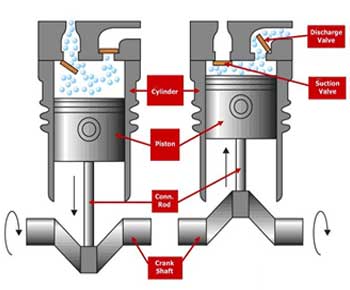
- Screw compressors

- Scroll compressors
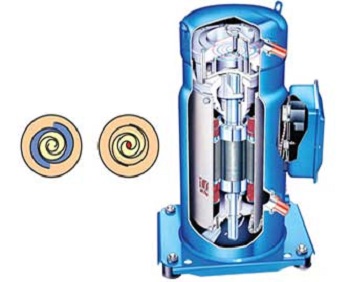
- Rotary compressors

- Centrifugal compressors
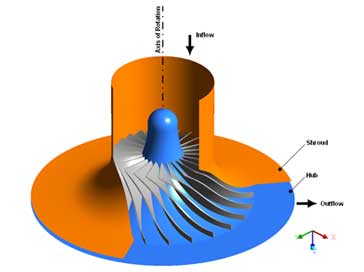
Centrifugal compressors (dynamic) are substantially different from the first four types of compressors in the list (positive displacement) in their working principle. In a positive-displacement compressor, a certain amount of gas is continuously reduced in volume by a piston, spiral, screw, or rotation, increasing the vapor pressure. Meanwhile, in a centrifugal compressor, the gas is compressed as a result of being accelerated by the rotation of an impeller followed by the reduction of the speed in a diffuser which increases the pressure. Centrifugal compressors are used in large-capacity applications.
As regards the enclosure sealing, compressors can be divided into the following three groups:
- Hermetic compressors
- Semi-hermetic compressors
- Open compressors
In hermetic compressors, the electric motor and the compressor are placed in an enclosed casing that cannot be opened for maintenance. As a result, this type of compressor is used in low-capacity applications. In a semi-hermetic compressor, the motor and the electric motor are enclosed in a two-piece casing. In other words, the motor and the compressor are in separate, distinct parts of the assembly. Such compressors come with mid-range capacity, which is more than a hermetic compressor. In an open compressor, the electric motor is separated from the casing enclosure and connected to it by a coupling. These compressors are usually made with high capacity.
The Condenser in Air Cooled Chiller
The condenser is a heat exchanger that allows heat transfer from the refrigerant to the air. The condenser in an air-cooled chiller is cooled by air. Air-cooled condensers are composed of copper tubes (running liquid refrigerant) and aluminum fins (for heat transfer with the passing air).

Overall, condenser comes in three types :
- Air-cooled
- Water-cooled (two-pipe condensers, shell-and-coil, shell-and-tube)
- Evaporative condensers
In air-cooled condensers, the air serves as the cooling agent for distilling the refrigerant, whereas water is used to cool the refrigerant in a water-cooled compressor. Moreover, evaporative condensers use both air and water. Although the temperature of the passing air increases to some extent in an evaporative condenser, the refrigerant is distilled by the evaporation of the water sprayed on the condenser and air serves to promote evaporation by removing the resulting vapor. Air-cooled vapor compression chillers often use the first type of condenser. The flow of air in air-cooled condensers can be of the following types:
- Natural, without using an aeration fan—such as in household refrigerators
- Flow created by a fan or a blower
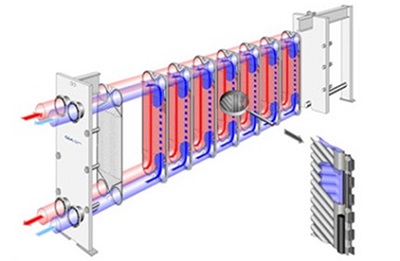
The Expansion Valve in the Refrigeration Cycle of Air Cooled Chiller
The expansion valve, by creating a pressure drop across the path of the refrigerant running to the evaporator, transforms liquid refrigerant to hot gas and, then, to cold gas. Depending on its design, the chiller expansion valve can be thermostatic, compression, or electronic.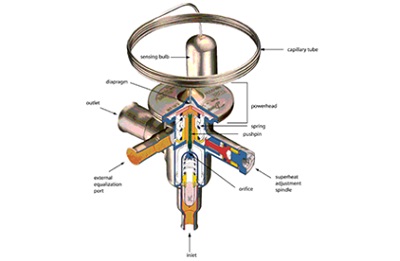
You can also read the article THE DIFFERENCE BETWEEN AIR COOLED CHILLER AND WATER COOLED CHILLER for more information.
Types of Evaporators used in Air-Cooled Compression Chillers
The evaporator, in cooling systems, is a heat exchanger that helps transfer heat from water to the gaseous refrigerant. Their function in air-cooled or water-cooled vapor compression chillers is to cool down the refrigerant (by transforming it to gas) to collect heat from the water coming from the fan coil or air handling units to the evaporator. Evaporators are categorized into three groups based on structure:
- Shell-and-tube: Often made of steel or copper tubes. This type of coil is used to cool down liquids (find further information under the Heat Exchangers category).
- Finned Evaporators: In a finned evaporator, as a type of shell-and-tube evaporator, fins are placed over the tubes as secondary heat transfer surfaces (increasing heat transfer from the tube to the air) to increase the external surface area, thus improving air-cooling efficiency. Furthermore, to prevent thermal dissipation, the evaporator surface can be insulated.
- Plate Evaporators: This type of evaporator integrates two metal plates with grooves that distribute the refrigerant. Another type of plate evaporator exists that is composed of a tube placed between two metal plates that are welded together at their ends. In this type of evaporator, the space between the two plates is filled with a eutectic solution to improve contact between the plates and the tube running the refrigerant.

Final speech
The specialized collection (Damatajhiz) (the first and most reliable authority in the country in the field of building facilities equipment and all air conditioning devices), offers you all kinds of sand filters and hundreds of other products, guaranteeing the originality of the product, valid warranty, and reasonable price. In addition, if you have any questions about choosing and comparing the brands of this product, you can get free advice from the heating equipment experts.
In Iran, the first and most famous specialized group in the field of building installation equipment, air conditioners, and all equipment for swimming pools, saunas, and jacuzzis since 2004, DamaTajhiz is a specialized group. Refer to the time of this group. For more information, you can get advice from the experts of DamaTajhiz Engineering and Production Company by calling 021-88822550.

We are waiting for your call and look forward to meeting you at the DAMATAJHIZ group
By sharing the above article on social networks, let your friends know about its important content.




Comments (0)